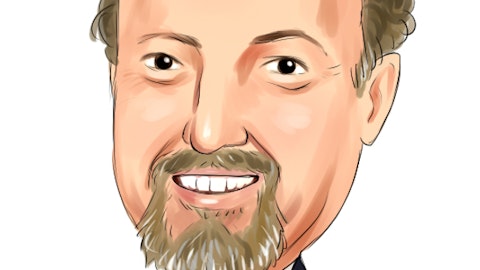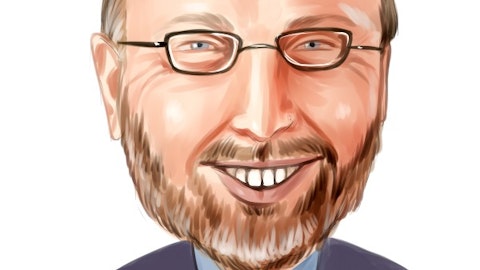When it comes to the size of the workforce, the sales force, I believe we have the right size. We have people with lots of very deep relationship with customers at go many year back and they know customers personally. They also understand the customer challenges. They understand what customers are trying to solve. So we’re not just trying to sell technology, we really bring to our customers’ ROI driven solutions. In terms of the sales commissions, we pay commissions based on obviously new bookings, but also renewals and renewals are very important for achieving our goals. And we also pay sales people accelerators for selling more innovation to our customers. So while we just reduced our booking expectations by $10 million for the year, $10 million ACV for the year.
But as sales people are more successfully selling cloud and innovation, they can get accelerators. And I hope that we’ll see many people coming to our [present] cloud next year as they achieve quarters.
Peter Levine: Maybe as a follow-up to, I think, Ryan’s first question was, given that you don’t really have visibility into when we’ll trough out here. So one is, what are your hiring plans into the second half and then what are your initial hiring plans as you think about fiscal ’25?
Dan Bodner: So right now, our guidance assumes flat operating expenses in Q2 and Q4, so similar to Q1. So we have no hiring plans, and we’re going to maintain the level of expense that we have now. And I think in this environment, it’s positioned us to really focus on getting the sales people we have today to build the pipeline. And as I said before, to push more innovation into our customer base and new logos. And as soon as we see signs that this pent-up demand that we see in our pipeline growth is starting to materialize then we obviously can change their view and resume hiring. But right now, for the remainder of the year, our guidance assumed that things will remain the same.
Operator: [Operator Instructions] And our next question comes from Mason Marin from Jefferies.
Mason Marin: So I wanted to focus on your existing customer base with regards to guidance. Are you seeing existing customers reduce licenses or are you seeing any change in the [churn] based on the macro environment? Any color there would be appreciated.
Dan Bodner: The only change is — the two changes that we see are [indiscernible] longer as they bring more executive into the approval cycle and there’s definitely growing interest in bots, and we launched the bots in June in our Engage Customer Conference. I think some of the analysts and investors, you were there and you saw the really excitement, customers were thrilled with the bots. We have now about 30-plus bots in our platform, we will introduce 15 more this year and we expect to introduce about 30 more next year. So very, very rapid innovation. And that’s because DaVinci AI is the core of the platform and it helps us to bring not just Verint AI, but any commercial gene AI to bring it into the platform, train it quickly on data and release new bots that augment the workforce to do different tasks.
So that’s clearly exciting customers. So on one hand, elongated sales cycle, on the other hand, more interest in bots and growing pipeline. So no, we didn’t change — no change in renewals, our renewals were strong in Q2. Gross renewals, low to mid-90s and more than 100% NRR. So renewal rates didn’t change. We saw big deals. We saw same term length, close to two and half years. So no different in behavior, no really difference in behavior other than the elongated sales cycle and the bot interest.
Mason Marin: And then on the deals that have been pushed out, are you seeing any clustering in a particular vertical or industry perhaps?
Dan Bodner: Not at all. It’s very random. Some things that we start two weeks and we already got some Q2 deals in Q3, so some of the deals are pushed just by a little other gets pushed by month. No rules, no industry pattern. It’s really company by company and just generally cautious approach to IT spending.
Mason Marin: Last one from me is you’ve talked a lot about your AI bots. How should we think about that impacting on like a per customer ARPU basis, any rule of thumb regarding like an ARPU uplift that you’re seeing from customers that are adopting?
Dan Bodner: So we talked last quarter on a potential 10x uplift that we see in our customer base, and that’s based on analyzing our top customers. This clearly — the spend on labor is very large in customer engagement. We talked about $2 trillion labor spend annually and bots — bots are really good at doing just one thing, right? Each bot is automating one task and it’s very easy for customers to kind of compare the price of their bots to the savings that they create. And obviously, they can deploy a large team of bots and save more than just on one task, but that makes them very easy to deploy from the platform, both are deployed embedded in workflow, so there’s no disruption to people while they’re doing their normal work, they’re getting help from bot.




